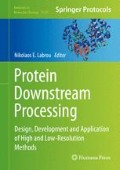Abstract
PEGylation is a common and highly accepted possibility for half-life prolongation of proteins by increasing the hydrodynamic size. The chromatographic purification of PEGylated protein, using PEG (poly-ethylene glycol) of different PEG chain lengths, with the example of lysozyme and a scFv, is described in detail here, and helpful suggestions for the purification of other PEGylated proteins are listed. The relevant characterization methods for PEGylated proteins, important for the successful purification, are also described. The purification starts with a CEX (cation exchange) chromatography leading to about 95 % purity for polishing HIC (hydrophobic interaction chromatography) is described.
Access this chapter
Tax calculation will be finalised at checkout
Purchases are for personal use only
References
Veronese FM (2001) Peptide and protein PEGylation: a review of problems and solutions. Biomaterials 22:405–417
Chapman AP (2002) PEGylated antibodies and antibody fragments for improved therapy: a review. Adv Drug Deliv Rev 54:531–545
Abuchowski A, McCoy JR, Palczuk NC et al (1977) Effect of covalent attachment of polyethylene glycol on immunogenicity and circulating life of bovine liver catalase. J Biol Chem 252:3582–3586
Abuchowski A, van Es T, Palczuk NC et al (1977) Alteration of immunological properties of bovine serum albumin by covalent attachment of polyethylene glycol. J Biol Chem 252:3578–3581
Fee C, Van Alstine J (2006) PEG-proteins: reaction engineering and separation issues. Chem Eng Sci 61:924–939
Seely JE, Richey CW (2001) Use of ion-exchange chromatography and hydrophobic interaction chromatography in the preparation and recovery of polyethylene glycol-linked proteins. J Chromatogr A 908:235–241
Yamamoto S, Fujii S, Yoshimoto N et al (2007) Effects of protein conformational changes on separation performance in electrostatic interaction chromatography: unfolded proteins and PEGylated proteins. J Biotechnol 132:196–201
Pabst TM, Buckley JJ, Ramasubramanyan N et al (2007) Comparison of strong anion-exchangers for the purification of a PEGylated protein. J Chromatogr A 1147:172–182
Moosmann A, Christel J, Boettinger H et al (2010) Analytical and preparative separation of PEGylated lysozyme for the characterization of chromatography media. J Chromatogr A 1217:209–215
Moosmann A, Blath J, Lindner R et al (2011) Aldehyde PEGylation kinetics: a standard protein versus a pharmaceutically relevant single chain variable fragment. Bioconjugate Chem 22:1545–1558
Cooper RA (2002) SDS-PAGE and western blotting of plasmodium falciparum proteins. Meth Mol Med 72:177–188
Laemmli UK (1970) Cleavage of structural protein during assembly of the head bacteriophage T4. Nature 227:680–685
Kurfürst MM (1992) Detection and molecular weight determination of polyethylene glycol-modified hirudin by staining after sodium dodecyl sulfate-polyacrylamide gel electrophoresis. Anal Biochem 200:244–248
Bailon P, Palleroni A, Schaffer C et al (2001) Rational design of a potent, long-lasting form of interferon: a 40 kDa branched polyethylene glycol-conjugated interferon alpha-2a for the treatment of hepatitis C. Bioconjugate Chem 12:195–202
Annathur GV, Buckley JJ, Muthurania K et al (2010) Application of arginine as an efficient eluent in cation exchange chromatographic purification of a PEGylated peptide. J Chromatogr A 1217:3783–3793
Arakawa T, Tsumoto K, Nagase K et al (2007) The effects of arginine on protein binding and elution in hydrophobic interaction and ion-exchange chromatography. Protein Expr Purif 54:110–116
Shukla D, Schneider CP, Trout BL (2011) Molecular level insight into intra-solvent interaction effects on protein stability and aggregation. Adv Drug Deliv Rev 63:1074–1085
Chennamsetty N, Helk B, Voynov V et al (2009) Aggregation-prone motifs in human immunoglobulin G. J Mol Biol 391:404–413
Baynes BM, Trout BL (2004) Rational design of solution additives for the prevention of protein aggregation. Biophys J 87:1631–1639
Moosmann A, Gerlach E, Lindner R et al (2012) Purification of a PEGylated single chain Fv. J Chromatogr A 1236:90–96
Müller E, Josic D, Schröder T et al (2010) Solubility and binding properties of PEGylated lysozyme derivatives with increasing molecular weight on hydrophobic-interaction chromatographic resins. J Chromatogr A 1217:4696–4703
Acknowledgments
This work was supported by the Bundesministerium für Bildung und Forschung (BMBF), Germany.
Author information
Authors and Affiliations
Corresponding author
Editor information
Editors and Affiliations
Rights and permissions
Copyright information
© 2014 Springer Science+Business Media, LLC
About this protocol
Cite this protocol
Moosmann, A., Müller, E., Böttinger, H. (2014). Purification of PEGylated Proteins, with the Example of PEGylated Lysozyme and PEGylated scFv. In: Labrou, N. (eds) Protein Downstream Processing. Methods in Molecular Biology, vol 1129. Humana Press, Totowa, NJ. https://doi.org/10.1007/978-1-62703-977-2_37
Download citation
DOI: https://doi.org/10.1007/978-1-62703-977-2_37
Published:
Publisher Name: Humana Press, Totowa, NJ
Print ISBN: 978-1-62703-976-5
Online ISBN: 978-1-62703-977-2
eBook Packages: Springer Protocols

